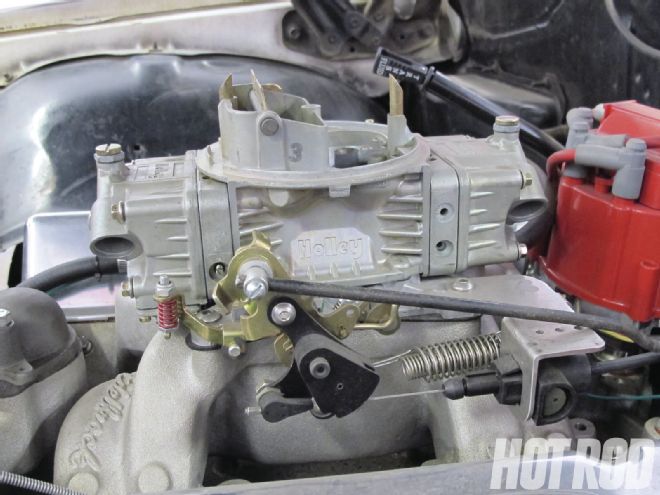
The Premise
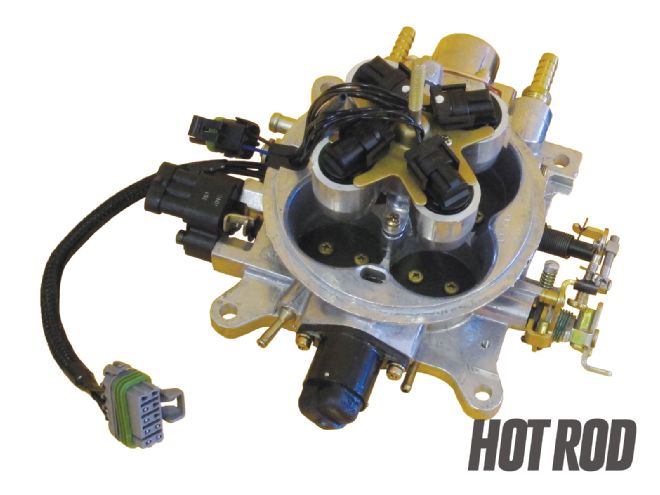 This test is of Holley’s most basic, simple-to-install electronic fuel injection. It uses a four-barrel throttle-body with integral injectors (TBI).
This test is of Holley’s most basic, simple-to-install electronic fuel injection. It uses a four-barrel throttle-body with integral injectors (TBI).
Out-of-the-box, no-tuning EFI setups are hot these days, since many folks want injection without having to touch a laptop computer. The point of these kits is that anyone totally clueless about wiring or custom tuning can install one and make it run with virtually no hassle. There are systems from Mass-Flo, FAST, and Professional Products, plus one that’s coming that we can’t tell you about yet. But the newest one on the market right now is the Holley Avenger EFI package. We’re here to find out if it works and what benefits it offers.
The Stuff
Holley now offers a full line of EFI components that are getting solid reviews, all the way up to the race Dominator controllers. The self-tuning line is called Avenger, and you can choose kits for throttle-body injection (TBI), in which the fuel injectors are in a single unit with the butterflies and bolts in place just like a carburetor, or for multipoint (MFI), which includes an injector for every cylinder, each located on a bung on the intake manifold’s runners.
For this test we chose the lowest-priced system using a throttle-body. Holley offers the following TBI options: a two-barrel unit for up to 275 hp, and 900-cfm, four-barrel units for three horsepower ranges (200-400, 375-525, and 450-600), with the difference being the fuel flow rating of the injectors. We used the 375-525 kit (PN 550-401).
The Test
The victim is our ’67 Impala convertible with a 383ci small-block from Smedding Performance. It’s as average as it gets, running a 231/236 hydraulic roller cam, Edelbrock Performer RPM heads, and an Edelbrock Air Gap intake. It’s advertised at 450 hp. The car also runs a Bowler 700-R4 overdrive trans and 3.08 axle gears. With a full tank and a driver, it abused the scales at 4,200 pounds.
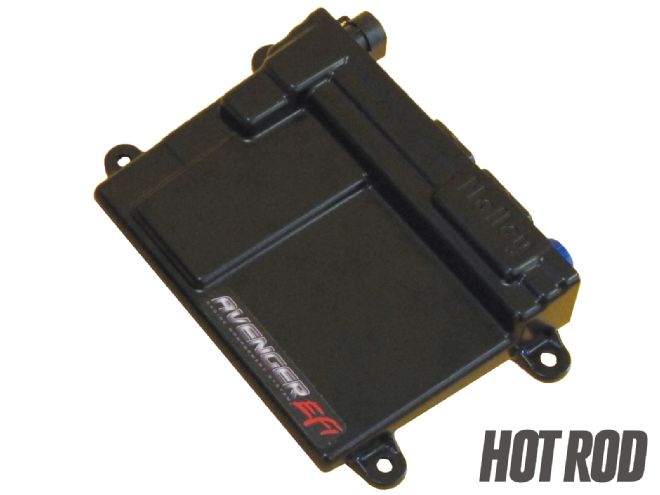 The Avenger EFI control box has a footprint of 81⁄2 x 6 inches, a max height of 113⁄16, and a mounting pattern of 73⁄4 x 31⁄2. The kit includes all the wiring, the hardware, a fuel pump, and filters, and it weighs 18.8 pounds in all.
The Avenger EFI control box has a footprint of 81⁄2 x 6 inches, a max height of 113⁄16, and a mounting pattern of 73⁄4 x 31⁄2. The kit includes all the wiring, the hardware, a fuel pump, and filters, and it weighs 18.8 pounds in all.
Our test regimen had three stages: the first using a Holley 3310 750-cfm, vacuum- secondary carb right out of the box, the second with the carb tuned to the best of our abilities, and the third with the Holley Avenger EFI. In each case we carefully noted driving impressions, monitored intake vacuum, checked air/fuel ratios with Holley’s PN 534-201 wide-band O2 gauge, and clocked gas mileage. Driving conditions included our everyday, 52-mile, stop-and-go round trip to work, plus various highway drives. First with the tuned carb and then with the EFI, we drove a repeatable, 130-mile loop on a highway with mildly rolling hills at 75 mph in virtually identical weather conditions, checking mileage by filling up at the same gas pump every time. We used Chevron 87-octane gas blended for July and August in SoCal. With the Avenger, we let it self-learn for a week before driving our mpg loop.
The data at idle was collected at 750 rpm, with the trans in gear in all cases. While the Avenger EFI does offer tuning of some parameters via the handheld controller, we left all the settings as delivered. We put about 1,000 miles on the tuned carb and another 1,000 on the EFI.
The Results
All our empirical data can be seen in the Test Results chart.
Out of the box, the carburetor seemed fine from the driver seat, though it was very rich, leaning out only at certain part-throttle loads because of a late-opening power valve. It delivered 9.5 to 12 mpg regardless of driving conditions, city or highway.
By adjusting the idle screws, increasing the jetting split front to rear, leaning it out, adding a larger squirter, and installing an 8.5 power valve, we made the carb quite a bit better. The idle quality improved, jumping up to 10.5 to 11.5 inches of vacuum with an AFR loping between 14.5 and 16.0:1 (the latter likely an O2 sensor confused by a loping cam). Throttle response was better, too. At cruise, we now had AFRs at 14.5 to 14.8:1, and at WOT it was a happy 12.5 to 12.8. In brutal traffic, the mileage still hovered around 10.5, but on the highway, our test loop saw 15.5 mpg. One perfect evening, cruising 60 to 65 mph, we saw a best of 17.7. In multiple tanks with normal, nontraffic conditions, the carb varied greatly, from 11 to 15.5 mpg.
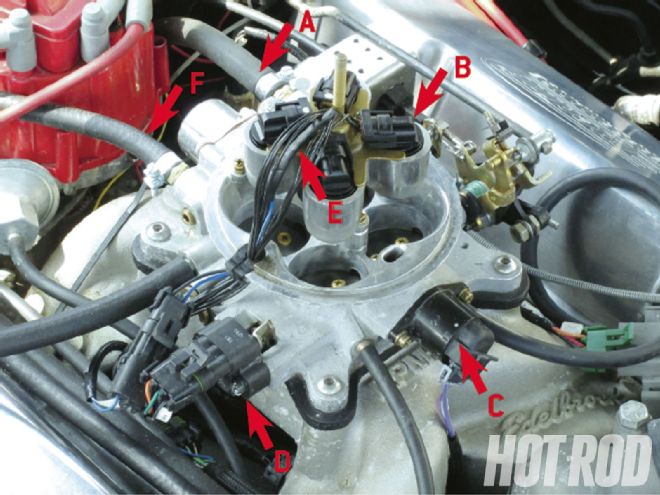 Most of the wiring plugs into the throttlebody itself. Seen here: A) fuel pressure in, B) four injectors, C) idle air control motor, D) throttle position sensor, E) inlet air temperature sender, and F) fuel return. The only remaining sensor to deal with is coolant temp, which goes into a water port just like any temp gauge sensor.
Most of the wiring plugs into the throttlebody itself. Seen here: A) fuel pressure in, B) four injectors, C) idle air control motor, D) throttle position sensor, E) inlet air temperature sender, and F) fuel return. The only remaining sensor to deal with is coolant temp, which goes into a water port just like any temp gauge sensor.
Both stock and tuned up, the carburetor cold-start performance was amazing; floor it one time and the sucker would fire to life in a quarter-turn of the starter and idle and drive perfectly with no warm-up time.
Now the Avenger TBI. Right off the bat, the idle quality was smoother, and we were amazed at the noticeable improvement in throttle response. It seems like “smoother and more throttle response” are claims in every snake-oil ad you’ve ever seen, but really, it was a big deal. The car even spun the tires more easily, though spin is a kind term for this land yacht.
But on the highway, win. During our test loop, the EFI gained 0.9 mpg over the carb, posting 16.4 mpg. In other drives on flatter roads, we saw as much as 18.9 mpg on a 75-mph trip, and in one 100-mile trip at 60, it posted 21.3. Those were anomalies, though, as it most often gets 12.5 to 16.5 mpg in nontraffic use.
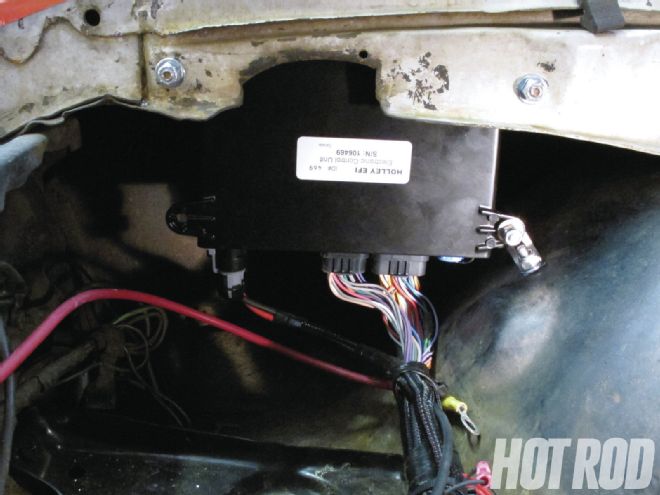 We found a handy spot for the computer just behind the battery in a fender cavity protected from water. The wiring is a little too short to give you lots of mounting freedom, but this location makes it work just right.
We found a handy spot for the computer just behind the battery in a fender cavity protected from water. The wiring is a little too short to give you lots of mounting freedom, but this location makes it work just right.
The most disappointing part for us was the cold start, where you’d think EFI would excel. Unlike with the carb, it takes a few seconds of cranking time before the engine starts, and the idle takes about a minute to sort itself out. Once it’s warm, there’s no issue, but in cold starts, the carb won. Holley’s EFI designer advised that the computer needs to see a certain amount of cranking rotations before it fires and that the HEI distributor’s tach output will never be as responsive as the refined sensors on a late-model car, so our crank time was normal. When warm, it fires quickly, probably because fuel vapor is still in the plenum. All that said, we could see how, in very cold conditions, the Avenger TBI might start when the carb just plain can’t atomize the fuel.
As for power, we did not test it on a chassis dyno, but there’s no difference in the seat of the pants other than right off idle. The EFI might make just a little more top end by virtue of the 900-cfm throttle-body versus the 750-cfm carb.
Analysis
The carb was pretty dang good, but the EFI was the winner in driveability (other than in cold starts) and had better idle vacuum.
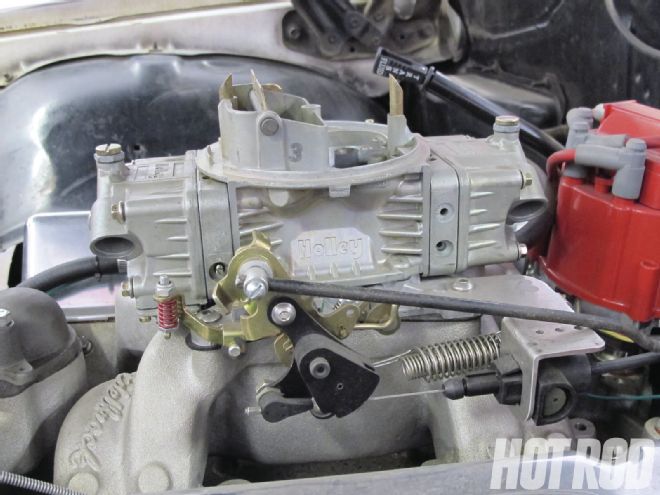 The throttle-body bolts in place of any Holley 4160 or 4150 four-barrel carb.
The throttle-body bolts in place of any Holley 4160 or 4150 four-barrel carb.
MPG varied considerably from tank to tank with both fuel systems. But in nontraffic use, the carb most often got 11.0 to 15.5 and the EFI was 12.5 to 16.5. Call it an annual gain of 1 mpg per tank for bench-racing purposes, and that’s fair. We are probably a little above average when it comes to tuning street-car carburetors, but we didn’t do anything that you couldn’t if you had a vacuum gauge and an AFR gauge. Yet if you fear touching a carb and only run them as delivered, then the Avenger will make a far greater improvement.
Why would the EFI get better mileage than the carb when the AFRs in various conditions were so similar? Some would say it’s due to the improved atomization of the fuel with the injection. With port injection we’d agree, but with a TBI and a wet manifold, we’re dubious. We think the bigger difference is in the moments of throttle transition when the injection is smoother, as it constantly seeks to adjust the air/fuel ratio to the optimum. The carburetor, with its accelerator discharge nozzle shooting gas into the primary barrels every time you apply throttle, makes for a lot of slop. On tip-in, we’d sometimes see the AFR with the carb go to 9.5:1 for a few moments. The TBI has accelerator enrichment as well, but it only went to 11.5:1 in similar conditions—and that can be made leaner with the handheld control, though we tested with all the default settings. Also, the carb continues to pull fuel during closed-throttle deceleration, while the injection has finer control. It all adds up.
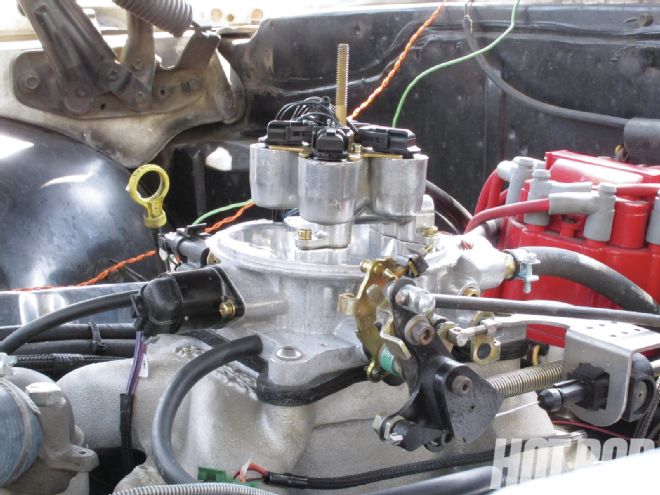 With a provided adapter, the linkage has the same holes and levers as the 3310 carb, making for easy throttle and trans-cable hookup.
With a provided adapter, the linkage has the same holes and levers as the 3310 carb, making for easy throttle and trans-cable hookup.
Conclusions
The first thing that must be said is that this kit drove almost perfectly from the very first mile. It was that good. Compared with the carb, the EFI has a very slight hesitation upon low-speed shift recovery, but that’s getting picky.
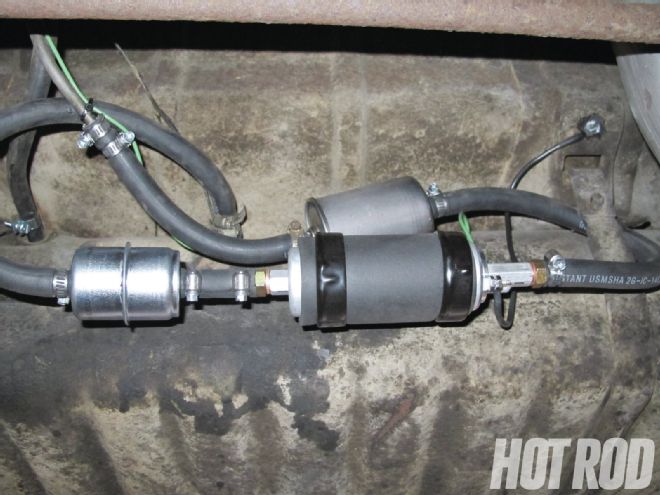 > The fuel pump, the prefilter, and the postfilter are all provided, though the fuel return line is not, and it presents the biggest hassle of the installation. We were lucky to have a nipple on the tank for an OE vent and were able to run a new line back to it and then change to a vented cap. The system runs at 21 psi.
> The fuel pump, the prefilter, and the postfilter are all provided, though the fuel return line is not, and it presents the biggest hassle of the installation. We were lucky to have a nipple on the tank for an OE vent and were able to run a new line back to it and then change to a vented cap. The system runs at 21 psi.
You can follow the installation overview in the photos. It was pretty easy; two of us handled it in a single day, and that’s with interruptions for pizza, shooting video, and parts runs. Speaking of which, the kit contained everything we needed other than the 20 feet of EFI-approved, rubber fuel line for the return, a handful of hose clamps, wire ties, and a vented gas cap (because we used the stock tank-vent bung for the return).
Overall, we were super impressed. However, the kit is not cheap at $1,999 from Summit Racing. Our carb and mechanical fuel pump cost $361.90 new, so the EFI is an extra $1,637.10. At an average improvement per tank of 1 mpg—say 15.5 mpg to 16.5 mpg—and at a gas cost of $3.80 per gallon, you’d have to drive a little more than 100,000 miles for the EFI to pay for itself. That’s unlikely in a hobby car, but then again, we usually get stuff for our cars that we want rather than need. And this does make the car better.
Bottom Line
The Holley Avenger EFI performs exactly as advertised. If you’re a guy who won’t fiddle with a carb and you want injection without any complication or computer mumbo-jumbo, get it.
Test Results
Test Stock Carb Tuned Carb Avenger EFI Idle vacuum 8-10 inches 10.5-11.5 inches 11.0-12.5 inches Idle AFR 12.5-12.8:1 14.5-16.0:1 14.2:16.0:1 WOT AFR 11.5-11.9:1 12.5-12.8:1 12.3-12.5:1 MPG in hideous traffic 9.0-11.0 mpg 9.5-11.0 mpg 10.0-13.0 mpg MPG during controlled test loop in rolling hills, 75 mph NA 15.5 mpg 16.4 mpg MPG at flat, 60-mph cruise* NA 17.7* 21.3* Typical MPG in no-traffic day-to-day use 11.0-12.0 mpg 11.0-15.5 mpg 12.5-16.5 mpg
* These are best-ever numbers, and atypical.
What Does Self-Learning Mean?
Electronic fuel injection controls all begin with what’s called a base map, a chart that identifies how much fuel needs to be delivered to achieve the target air/fuel ratio under various driving conditions, taking into account the load (based on rpm, throttle position, and manifold vacuum), the coolant temperature, and the inlet air temperature. The Avenger EFI always operates in closed-loop mode, which means that it reads the air/fuel ratio from the oxygen sensor in the exhaust pipe, then adds or subtracts the amount of fuel squirted into the engine to achieve the target air/fuel ratio on the base map.
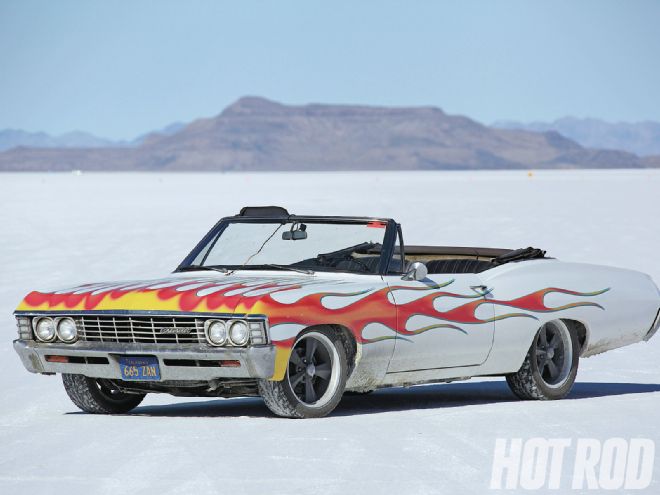 All this testing happened with our old convertible, which also made the trip to Bonneville. We hope to test the Avenger TBI versus a StealthRam port-injection intake. Next, this thing needs a skin peel, some primer, and more power.
All this testing happened with our old convertible, which also made the trip to Bonneville. We hope to test the Avenger TBI versus a StealthRam port-injection intake. Next, this thing needs a skin peel, some primer, and more power.
In high-end, aftermarket EFI, that map is customized with a computer program to meet the needs of the engine. With self-learning setups like the Holley Avenger, the base map is established at the factory, with the developers creating various maps they know will work well with typical engines. The Avenger uses a handheld controller to ask a number of simple questions about how the engine is built, such as displacement and cam type, then overlays the best areas of each preloaded map and blends them together into a base map that is very close to what the engine will really need and is safe for running.
Next, the computer has what Holley calls a learn map. As the car is driven and the closed-loop system adjusts the fuel delivery, the learn map basically tells itself, OK, so it took 15 percent less fuel than what’s on the base map to hit the target AFR at this point. I’ll remember that. When the learn map knows the real amount of fuel the engine wants under those conditions, instead of what’s estimated on the base map, it can deliver that ideal amount in the future. By then running off the smarter learn map, the closed-loop fuel-delivery compensation is far more refined; it might only need a 1 or 2 percent adjustment rather than a 10 to 30 percent adjustment. That allows the computer to react more quickly and make for a better overall operation.
When you drive under a wide variety of conditions, the computer eventually creates a very thorough learn map that knows exactly what your engine wants. You can follow this happening, as one of the outputs on the handheld device shows you the closed-loop compensation. When it starts running at plus or minus 5 to 10 percent all the time, you’re dialed and can turn off the self-learning feature. The map won’t be as perfect as a what a race tuner could do on a laptop, but it will be far better than good enough for a typical street/strip car. And, if you want, you can still plug in a laptop and continue tweaking any way you want in the future.
That’s simplified, but now you get the basics.